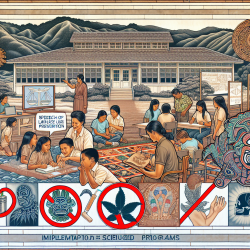Introduction
As practitioners in the field of education and therapy, understanding the determinants of successful program implementation is crucial. The recent study, "Examining implementation determinants of a culturally grounded, school-based prevention curriculum in rural Hawai‘i," offers valuable insights into the factors that influence the adoption and sustainability of prevention programs in diverse school settings. This research is particularly relevant for those working with Native Hawaiian and Pacific Islander (NHPI) youth, who face higher rates of substance use and related health disparities.
Understanding the Study
The study utilized a five-phase, mixed-methods approach to develop and validate a measure of implementation determinants for a culturally grounded drug prevention curriculum. This curriculum, known as Ho’ouna Pono (HP), was designed to address the unique cultural and educational needs of NHPI youth in rural Hawai‘i. The research identified 50 barriers and 27 facilitators to implementation, categorized into four main factors: Innovation Barriers, HIDOE State-Level Barriers, Teacher-Level Barriers, and Administrator-Level Barriers.
Key Findings
- Innovation Barriers: These include challenges related to the curriculum itself, such as its perceived value and adaptability to current educational priorities.
- HIDOE State-Level Barriers: Broad educational policies and priorities that may conflict with the implementation of drug prevention programs.
- Teacher-Level Barriers: Teachers' attitudes and beliefs about drug prevention, as well as their perceived need for the curriculum.
- Administrator-Level Barriers: Role conflicts and turnover among school administrators that can disrupt program implementation.
Implications for Practitioners
For practitioners looking to improve their skills and outcomes in implementing prevention programs, this study offers several actionable insights:
- Address Multi-Level Barriers: Consider the various ecosystemic levels that impact program implementation, from national policies to individual teacher perceptions.
- Promote Cultural Relevance: Ensure that prevention programs are culturally grounded and relatable to the target youth population, enhancing engagement and effectiveness.
- Leverage Facilitators: Identify and utilize facilitators that align with both administrative goals and student needs, such as the developmental appropriateness of the curriculum.
Encouraging Further Research
This study highlights the importance of ongoing research to understand the unique challenges and opportunities in implementing culturally grounded prevention programs. Practitioners are encouraged to engage in further research to tailor interventions to their specific contexts and to contribute to the growing body of knowledge in this field.
Conclusion
By understanding and addressing the determinants of successful implementation, educators and therapists can enhance the sustainability and impact of prevention programs for NHPI youth. This research serves as a valuable resource for those committed to achieving health equity and improving educational outcomes in rural and diverse settings.
To read the original research paper, please follow this link: Examining implementation determinants of a culturally grounded, school-based prevention curriculum in rural Hawai‘i: A test development and validation study.










